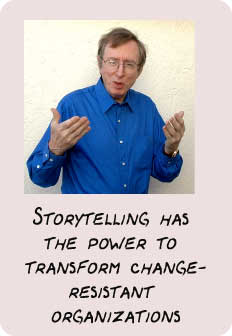|
|
Katalina Groh, Larry Prusak: Some of the world's leading thinkers |
| Storytelling to ignite change: Steve Denning |
 |
The
impact of storytelling
Stories can be used for all sorts of things in an organization or a community or a society. They can be used:: · entertainment;Different purposes require different kinds of stories, and it is the use of stories to change organizations that I am talking about in this presentation. As I describe the kinds that change organizations, it is important to keep in mind that I am talking that different kinds of stories are needed |
| to achieve different purposes. One of
the most important things to keep in mind in using stories in organizations
is to get clear, and stay clear, on the purpose for which the story is
being used. Because we human beings find stories such fascinating things,
it is all to easy to get interested in the story for its own sake, and
lose sight of the purpose for which we set out to use the story.
Stories that change organizations How do stories that change
organizations work? Well, when I say, “Let me tell you something that happened
to our task team in Pakistan, and they got advice from someone working
on Jordan, and there was the guy writing the book in Argentina, and then
there was the head of the highways authority in South Africa, and then
the people providing guidelines from New Zealand, and all this came back
to Pakistan, and what we learnt from the experience went into the knowledge
base in Washington,” when I say all that, we are sitting here in a room
in Orlando Florida, but if you have been following the story, in fact you
have been whizzing around the world and back in about fifteen seconds.
Getting inside an idea And what happens is that listeners get inside the idea. They live the idea. They feel the idea as much as if they were the task team there in Pakistan, not knowing what to do about some urgent but obscure question and then almost miraculously getting the answer so rapidly. They experience the story as if had lived it themselves. In the process, the story, and the idea that resides inside it, can become theirs. They don’t experience the story as an external observer, standing back, like a scientist in a white coat and appraising the experience, like some kind of voyeur or as a critic, but rather as a participant, someone who is actually living and experiencing and feeling the story.
|
| Books and videos on storytelling *** In Good Company : How Social Capital Makes Organizations Work by Don Cohen, Laurence Prusak (February 2001) Harvard Business School Press *** The Social Life of Information, by John Seely Brown, Paul Duguid (February 2000) Harvard Business School Press *** The Springboard : How Storytelling Ignites Action in Knowledge-Era Organizations by Stephen Denning (October 2000) Butterworth-Heinemann *** The Art of Possibility, a video with Ben and Ros Zander : Groh Publications (February 2001) |
| The views expressed on this website are those of Stephen Denning, and not necessarily those of any person or organization |
| Site optimized in 800x600: webmaster CR WEB CONSULTING |
|
|
|
|